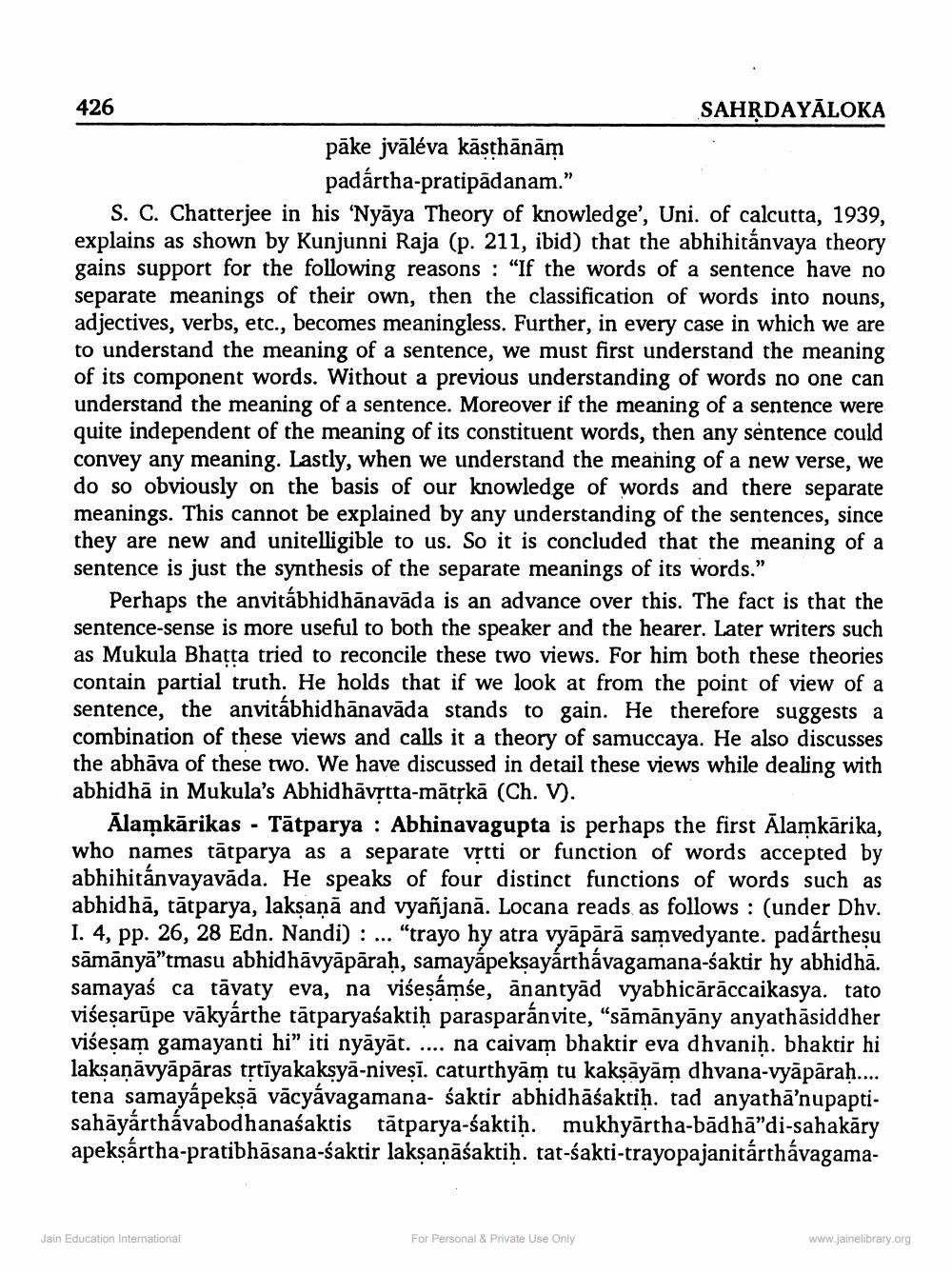________________
426
SAHĶDAYĀLOKA päke jvāléva kästhānām
padártha-pratipādanam." S. C. Chatterjee in his 'Nyāya Theory of knowledge', Uni. of calcutta, 1939, explains as shown by Kunjunni Raja (p. 211, ibid) that the abhihitánvaya theory gains support for the following reasons : "If the words of a sentence have no separate meanings of their own, then the classification of words into nouns, adjectives, verbs, etc., becomes meaningless. Further, in every case in which we are to understand the meaning of a sentence, we must first understand the meaning of its component words. Without a previous understanding of words no one can understand the meaning of a sentence. Moreover if the meaning of a sentence were quite independent of the meaning of its constituent words, then any sentence c convey any meaning. Lastly, when we understand the meaning of a new verse, we do so obviously on the basis of our knowledge of words and there separate meanings. This cannot be explained by any understanding of the sentences, since they are new and unitelligible to us. So it is concluded that the meaning of a sentence is just the synthesis of the separate meanings of its words
Perhaps the anvitábhidhānavāda is an advance over this. The fact is that the sentence-sense is more useful to both the speaker and the hearer. Later writers such as Mukula Bhatta tried to reconcile these two views. For him both these theories contain partial truth. He holds that if we look at from the point of view of a sentence, the anvitábhidhānavāda stands to gain. He therefore suggests a combination of these views and calls it a theory of samuccaya. He also discusses the abhāva of these two. We have discussed in detail these views while dealing with abhidh, in Mukula's Abhidhāvrtta-mātrkā (Ch. V).
Alamkārikas - Tātparya : Abhinavagupta is perhaps the first Alamkārika, who names tātparya as a separate vstti or function of words accepted by abhihitånvayavāda. He speaks of four distinct functions of words such as abhidhā, tātparya, laksana and vyañjanā. Locana reads as follows: (under Dhv. I. 4, pp. 26, 28 Edn. Nandi) : ... “trayo hy atra vyāpārā samvedyante. padártheșu sāmānyā”tmasu abhidhāvyāpāraḥ, samayápeksayárthávagamana-śaktir hy abhidhā. samayaś ca tāyaty eva, na višeşámse, ānantyād vyabhicārācсaikasya. tato višesarūpe vākyárthe tātparyaśaktiḥ parasparánvite, “sāmānyāny anyathāsiddher višesam gamayanti hi" iti nyāyat. .... na caivam bhaktir eva dhvanih. bhaktir hi lakṣaṇāvyāpāras tệtīyakaksyā-niveșī. caturthyām tu kaksāyām dhvana-vyāpāraḥ.... tena samayápeksā vācyávagamana- śaktir abhidhāśaktih. tad anyathā'nupaptisahāyárthávabodhanaśaktis tātparya-saktih. mukhyārtha-bādhā"di-sahakāry apekşártha-pratibhāsana-śaktir lakṣaṇāsaktiḥ. tat-sakti-trayopajanitárthávagama
Jain Education International
For Personal & Private Use Only
www.jainelibrary.org




